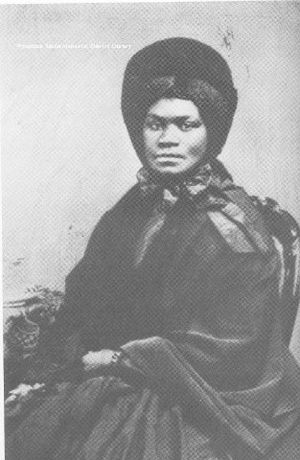Lisette Denison Forth facts for kids
Quick facts for kids
Lisette Denison Forth
|
|
|---|---|

Daguerrotype of Lisette Denison Forth
|
|
| Born | c. 1786 Detroit, Michigan
|
| Died | August 7, 1866 (aged 79–80) |
Lisette Denison Forth (born around 1786 – died August 7, 1866) was an amazing African-American woman from Michigan. She was born into slavery but became a successful landowner. Lisette was also a kind person who gave money to help others, which is called being a philanthropist. She worked as a maid for many years before owning land and helping build a church.
Lisette's Early Life and Fight for Freedom
Lisette Denison Forth was born in 1786 near Detroit. She was the second of six children born to Peter and Hannah Denison. Her family was enslaved by William and Catherine Tucker. Her father worked on the farm, and her mother worked inside the house.
When William Tucker died in 1805, he said that Peter and Hannah Denison would be freed after his wife, Catherine, died. However, he gave the Denison children to his brother. The next year, Peter and Hannah Denison became free. They started working for Elijah Brush. He told them to go to court to free their children. This was possible because of the Northwest Ordinance, a law that said slavery was not allowed in that area.
In 1807, the Michigan Supreme Court heard their case. But the court decided that only the youngest child, who was born after the Northwest Ordinance became law, could be freed.
Soon after, Judge Augustus B. Woodward made an important decision. He said that the Michigan Territory did not have to send enslaved people back to slavery if they had become free by living in Canada. Because of this new rule, Lisette and her brother went to Canada. They lived there for a short time to gain their freedom.
Becoming Free and a Landowner
Around 1815, Lisette and her brother came back to Detroit. Lisette started working as a domestic servant, which means she worked in people's homes. In the 1820s, she worked for Solomon Sibley. She had a good relationship with the families she worked for. Lisette was smart with her money and saved her pay. She used her savings to buy land.
In 1825, Lisette bought four pieces of land in Pontiac, Michigan. This made her the first Black person to own property in that city! She never lived in Pontiac herself. Instead, she rented the land to her brother Scipio. She later sold these properties in 1836 or 1837. Today, this land is part of Oak Hill Cemetery. There is a special historical marker there to remember her ownership.
In 1827, Lisette married Scipio Forth. He owned a business that moved goods. Sadly, he died only three years later.
In 1831, Lisette began working for John Biddle. He was the mayor of Detroit and started the city of Wyandotte, Michigan. Lisette kept investing her money. She bought shares in a steamboat and a bank. In 1837, she bought another piece of land in Detroit. Lisette spent a lot of time at the Biddle family's home in Wyandotte. In 1849, she even went with them to Philadelphia.
By 1854, Lisette was back in Detroit. She lived in her own home at what is now 328 Macomb Street. This spot is also a state of Michigan Historic Site. The Biddles later asked her to come to Paris to care for Eliza, John Biddle's wife, who was sick. Lisette and Eliza Biddle became good friends. Both women were Episcopalians, a type of Christian faith. They made a promise to each other that they would one day build a church.
Lisette returned to Michigan in 1856. She then worked for William S. Biddle, John Biddle's son. She worked at his home on Grosse Ile. This was a very wealthy, all-white community. Lisette died on August 7, 1866. She passed away shortly after Eliza Biddle. Lisette is buried in Elmwood Cemetery.
Building St. James Episcopal Church
When Lisette Forth died, she left some of her money to her family. The rest, about $3,000, was to be used to build a church. Lisette's gift was the largest part of the money needed. William Biddle knew his mother Eliza's wish to build a church. So, he added some of his own money and some of his mother's money to Lisette's contribution.
William's brother, James Biddle, gave the land for the church. The brothers hired an architect named Gordon W. Lloyd to design the building. James Biddle also made an altar cross, a kneeling bench, and a reading stand for the minister. Construction of the church began in 1867 and was finished in 1868. The first church services were held in the spring of 1868. Reverend Moses Hunter led these services.
Bishop Samuel Allen McCoskry officially dedicated the church in July 1868. He later wrote about it, saying:
This church was built because of the hard work and service of a loyal Black Christian. For years, she saved her money for this goal. Long before she died, she promised her savings to the Church of Christ. This was done with the plan of someone she had served for a long time, to join her in this holy act. Things happened that stopped this person's wish from coming true. But two of her sons faithfully carried it out. They gave the money needed to finish the church. And now it stands, simple and beautiful, as a shared act of a Christian family, to provide a house of prayer for everyone, rich and poor.
The church's red doors are dedicated to Lisette Forth. There is also a historical marker at the church site. It tells the story of both the church and Lisette Forth.


